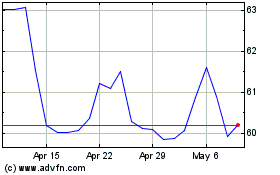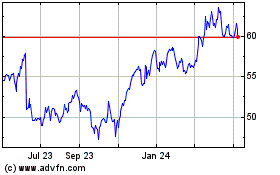US Regulators Take Aim At Trades Made In Error
February 16 2012 - 5:02PM
Dow Jones News
U.S. regulators are preparing to clamp down on firms that send
so-called rogue orders into the stock market, citing concerns that
an erroneous trade could ricochet across exchanges and ensnare
investors.
Such trades are usually caused by data-input errors, and their
frequency has fallen in recent years as markets have adopted more
computer-driven strategies and exchanges have increased
surveillance efforts to stamp them out.
However, electronic trading's split-second pace and increasingly
interconnected nature has spurred regulators to take a closer look
at the potential spillover effect of stock orders submitted far
from the prevailing market price.
A major concern is the impact of a big error in an automated
strategy set up to buy and sell component shares of a benchmark
index such as the Standard & Poor's 500, which authorities fear
could influence other electronic traders' strategies and erupt into
a market-moving event.
"It could take on a life of its own," said Thomas Gira,
executive vice president of market regulation for the Financial
Industry Regulatory Authority, or Finra.
"The velocity of the market has picked up," said Gira in an
interview. "When trading was slower, people still made mistakes,
but now there's potential for a programming error or computing
issue to spit out quotes in a rapid-fire manner and give rise to
[problematic] situations."
Getting caught on the other side of a trade that is deemed in
error and cancelled by exchange officials can also be a headache
for individual investors, who may have jumped at a price that
appeared a good deal, or used proceeds from such a trade to buy
other stocks.
Exchange operators deem transactions entered at prices wildly
off the going market rate to be "clearly erroneous" and eligible to
be voided upon request, and regulators in the past have
occasionally sanctioned traders for such mistakes.
Finra is now weighing tougher measures including enforcement
actions as officials examine 20 to 30 cases of erroneous trades
executed in recent months, deploying new rules passed last summer
by the Securities and Exchange Commission that require tighter
credit and risk controls over traders' activity. Gira said Finra is
watching out for serial or egregious offenders.
Following the May 2010 "flash crash," when investors protested
after exchanges cancelled thousands of trades, U.S. stock market
operators drew up new market-wide standards for when transactions
should be voided, which helped bring down the number of errors. The
introduction last year of rules governing the way traders gain
access to domestic stock markets are expected to further reduce
mistakes.
"It's in everybody's best interest for these things to be
minimized," said David D'Amico, head of operations for Direct Edge,
which runs two electronic stock exchanges. He said his markets now
see fewer than 10 erroneous trading episodes per month.
But regulations set up to ensure investors receive the most
competitive prices on share trades have increased the potential for
trade errors to reverberate across multiple markets. About
two-thirds of mistaken trades involve orders that are carried out
on more than one stock exchange, with the firm placing the order
sometimes not knowing where all of its business was transacted.
The high speed of electronic trading combined with strategies
set up to react to minute price movements and the incorporation of
leveraged securities like exchange-traded funds carries further
potential to magnify mistakes, said Bernard McSherry, a senior vice
president with brokerage firm Cuttone & Co. and an assistant
professor of finance at New Jersey City University.
"The market has put in place these self-reinforcing loops that
can amplify errors and create new problems," said McSherry, who
started as a stock broker in the 1970s. "Both people and machines
are not infallible, but the question is how you design
protections."
-By Jacob Bunge, Dow Jones Newswires; 312 750 4117;
jacob.bunge@dowjones.com
Nasdaq (NASDAQ:NDAQ)
Historical Stock Chart
From Apr 2024 to May 2024

Nasdaq (NASDAQ:NDAQ)
Historical Stock Chart
From May 2023 to May 2024
